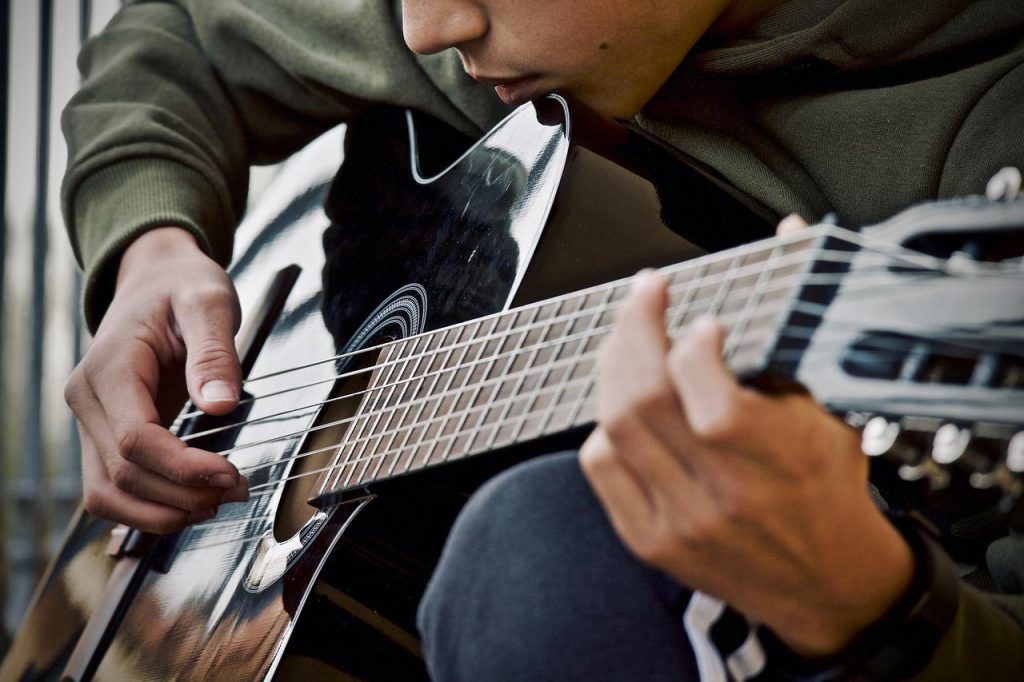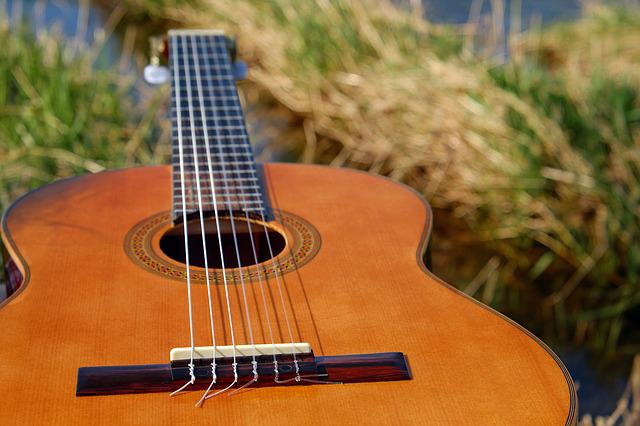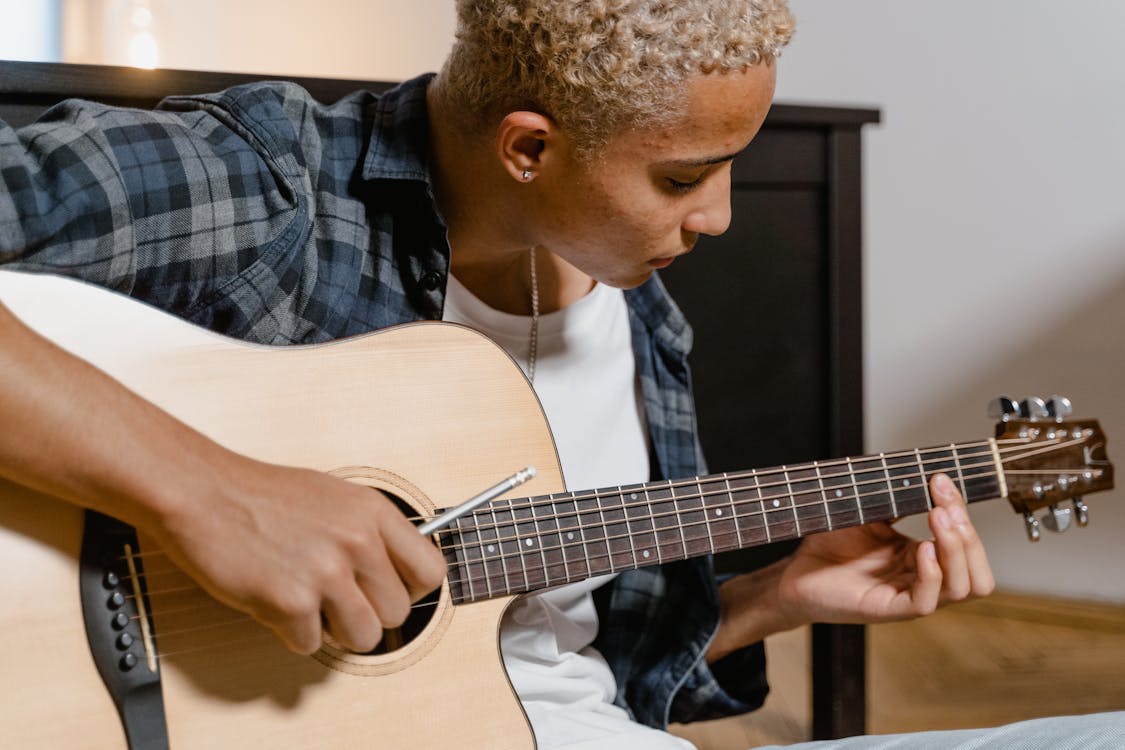Are you in the market for an acoustic guitar as a beginner? Almost 7% of the global population can play the guitar. The acoustic guitar has a wide range of classical and popular music uses, making it one of the most fascinating and satisfying instruments to master.
For starters, purchasing a guitar for the first time might be scary. There are many different guitars with so many distinct functions and price ranges.
Learning a few basic characteristics of the instrument can make purchasing your first acoustic guitar much easier. This article highlights all you should know while purchasing acoustic guitars.
How to Choose an Acoustic Guitar for Beginners: 5 Easy Ways
There are many factors to consider when looking for an acoustic guitar.
1. Acoustic Guitar or an Acoustic-Electric Guitar
Acoustic-electric guitars are equipped with electronics that allow them to be connected to amplifiers. To be amplified or recorded, non-electric acoustic guitars must be equipped with a microphone device or played into a microphone.
Acoustic-electric guitars are usually more expensive than acoustic guitars. Still, if you’ll be performing in a band or in front of an audience frequently, it’s something to think about.
Many acoustic-electric guitars also include a built-in tuner, which many players find handy.
2. Choose a Body Type that Flatters You
Classical guitars are frequently utilized in classical guitar performances. They are sometimes preferred by guitarists that perform a lot of fingerpicking since they have a lot of balance and clarity between the highs, mids, and lows.
Classical guitars have a unique shape that produces warm tones with great sustain while jumbos offer plenty of volume with strong mids and lows.
It is also important to note that some guitarists choose an asymmetric body shape if they want extra comfort when playing certain chords or techniques on their instrument.
Overall, all guitars need to be kept clean at any moment to produce soothing sounds.
3. Choosing Your Price Point
Before you delve into the differences between guitars in various price ranges, you must first choose how much you are willing to spend. Find your limit and work your way up from there.
Even if you’re a novice, most people advocate against spending less than $300 on a new guitar since the quality will make it sound inferior and difficult to play.
Most well-known guitar manufacturers offer models in every price range. However, some brands excel at specific price ranges. Fender, Epiphone, Yamaha, Takamine, Taylor, Washburn, and Martin are among the brands to consider.
- Both Fender and Yamaha provide acoustic guitars well-received by beginners on a budget.
- Washburn, Epiphone, and Takamine offer excellent acoustic guitars for those with a larger budget.
- Taylor and Martin make many high-end acoustic guitars. The price of these guitars will be higher but for a good cause.
A novice will anticipate upgrading guitars at some point. It will have little need for the finer points that distinguish a high-end guitar from a cheap instrument.
It’s crucial to examine how much guitar experience you have because this will influence how much you spend.
For instance, If you have more experience with the guitar, you should aim for something between $700 and $1200. Something in the $1200- $2500 area will last you a lifetime if you’re a pro.
4. Look at the Neck
As a novice, you’re unlikely to know how much forward bow is suitable, so I recommend seeking out a straight neck, which most players like in any case.
However, if it has a slight forward curve, that’s fine because it’s standard for guitar manufacturers. The most important component determines how high the strings are from the neck on an acoustic guitar.
The more motion there is, the more difficult it is to fret the strings. However, if there is a back-bow, the strings will be too low, causing buzzing.
5. Verify the Intonation
The capability of the guitar to play in tune is known as intonation. That is where you’ll need a more experienced companion or at least a few chords to test it out.
First and foremost, the headstock tuners must be solid but smooth, and the strings must be easily tunable to pitch.
Then, along the string, play a few chords and single notes. If the strings are in tune yet the chord sounds off, something is amiss and has to be fixed.
The fundamental parts of what is referred to as a “setup” are intonation and action. If you’re purchasing used, either has the retailer fix it or reduce the price.
| Factor | Description |
|---|---|
| Budget | Determine how much you’re willing to spend. Entry-level acoustic guitars start around $100, but better quality ones can cost several hundred dollars or more. |
| Body Shape | Acoustic guitars come in various body shapes, including dreadnought, concert, and parlor. Each shape affects the sound, tone, and playability of the guitar. Consider which shape best suits your playing style and preferences. |
| Wood Type | The type of wood used affects the tone, sustain, and overall sound quality of the guitar. Some popular options include spruce, mahogany, and cedar. Consider which wood type suits your playing style and preferred sound. |
| Neck Width and Shape | A narrower neck width is easier to play for beginners, but some people prefer wider necks for fingerpicking or strumming. The neck shape should also feel comfortable in your hand. |
| Action | Action refers to the distance between the strings and the fretboard. Lower action is easier to play, but too low can result in buzzing. Check the action and adjust if necessary. |
| Brand Reputation | Choose a reputable brand with a history of producing quality instruments. Research reviews and feedback from other players to ensure you’re getting a guitar that will last and perform well. |
| Playability | Test play the guitar before purchasing to ensure it feels comfortable and easy to play. Pay attention to the action, neck width, shape, and overall feel of the guitar. |
| Extras | Some acoustic guitars come with extras such as built-in electronics, cutaway bodies, and inlays. Consider which extras are important to you and your playing style. |
What color is a good acoustic guitar?
What color is good for an acoustic guitar depends largely on personal preference. Many beginners opt for classic wood finishes such as natural maple, mahogany, and rosewood.
These are all great choices that can stand the test of time, and they look stunning when played in any setting. Additionally, many guitars come with either glossy or matte finishes which can influence their visual appeal.
Those who want to make a statement with their acoustic guitar may opt for bolder colors such as sunburst finishes, black, white, and even blue.
While these colors may seem unconventional at first glance, they often bring out the true essence of an instrument that is designed to produce beautiful music.
It is important to note that the quality of sound from an acoustic guitar is not determined by its color but by the materials used in its construction such as wood type and string tension.
How do I choose the right size acoustic guitar?
When it comes to choosing the right size acoustic guitar, there are several factors to consider. The first is the scale length, which refers to the distance between the nut and the bridge of the guitar.
Longer scale lengths produce a deeper sound but can be more difficult to play for a new guitarist. Shorter scale lengths provide an easier playing experience, but may not have as much depth in their sound.
The body size of an acoustic guitar is also an important factor for novice players. Smaller-sized bodies are usually lighter and easier to handle, while larger-bodied guitars typically provide more volume and projection.
It’s important to find a balance between these two aspects – too small of a body may not have enough projection while too large of a body could be uncomfortable or difficult to play.
What size string is best for acoustic guitars?
The size of strings that are best for acoustic guitar will depend largely on the individual player and the type of sound they are trying to achieve.
Generally, lighter gauge strings (anywhere from .010 to .052) will be better suited for those looking for a softer, more mellow sound. These strings require less finger strength, making them ideal for beginners or those with smaller hands.
Heavier gauge strings (.053 to .070) will provide a fuller tone with more projection, which is perfect for those who want a louder sound. While they may require slightly more finger strength, these strings also offer greater sustain and clarity.
When it comes to choosing the right string size for an acoustic guitar, the most important factor is personal preference and playing style.
Additionally, it is important to keep in mind that different types of strings have their unique sonic characteristics which can affect how your instrument sounds as a whole.
Nylon-wound strings typically produce warmer tones while steel-wound strings tend to have brighter overtones; therefore it is important to consider all aspects when selecting the appropriate string size for your needs.
What is the best shape for an acoustic guitar?
The best shape for an acoustic guitar is subjective and largely depends on personal preference.
Different shapes can create different sounds, so it’s important to try out as many instruments as possible to find the one that has the sound you are looking for.
Common shapes include dreadnought (the most popular choice among beginners due to its full sound), classical (a smaller body with a deep resonant tone perfect for fingerpicking styles), and parlor (a shallow body that produces a warm, mellow sound).
Ultimately, the best shape for an acoustic guitar will depend on both physical comfort and sound quality; it is always recommended that you try out as many instruments as possible to find the one that meets your individual needs.
What to do when you first get an acoustic guitar?
When you first get an acoustic guitar, the best thing to do is familiarize yourself with the instrument.
Start by inspecting all of the components to ensure everything looks right and works properly. Next, look at the strings and make sure they aren’t too loose or too tight.
Check for any fraying or wear on the strings as well. Additionally, check that the frets are not sticking out of the neck and that there are no sharp edges around them.
Once you have checked over your guitar, it’s time to start playing! If you don’t know how to play yet, there are a plethora of tutorials available online and in books that can teach you the basics.
Beginners should start with basic chords such as open E and A major to get comfortable with finger placement and chord transitions. These simple chords can help new players learn to time and build up their muscle memory quickly.
As your playing progresses, it’s important to practice regularly to improve your skillset. Make sure to dedicate enough time every day or week so that you get plenty of practice before each session ends.
How long will an acoustic guitar last?
An acoustic guitar can last for many years with proper care and maintenance.
The longevity of an acoustic guitar will depend on the quality of materials used in its construction, how often it is played, and how well it is cared for over time.
High-end guitars are usually made from solid woods such as spruce or mahogany which provide a richer sound compared to lower-quality models that may use cheaper materials such as plywood or laminate. Solid wood also holds up better to wear and tear from regular playing.
In addition to using high-quality materials, it is important to keep your instrument clean and lubricated so that all parts remain in good working order.
This involves regularly wiping down the strings and body with a clean cloth to remove any dust or sweat build-up, as well as maintaining the neck and bridge by lightly oiling them every few months.
Finally, it is important to store your guitar in a hardshell case whenever you aren’t playing it to keep out dust and other elements. A good quality case can also help protect against bumps and scratches during transportation.
With proper care, an acoustic guitar can last for many years—just remember to take the time to look after your instrument and enjoy its music for years to come!
What to Look for in an Acoustic Guitar Package?
- Have light gauge strings inserted (11 gauge would be enough)
- When you buy a new guitar, get a protective case for it.
- Get a couple of picks between 38 mm and 46 mm thick-thin ones that are excellent while learning.
- Capo
- Get a free phone app with a guitar tuner and metronome.
Frequently Asked Questions
Is it possible to learn guitar within a month?
It takes around 1-2 months to play beginner guitar songs comfortably. Besides, it can take about 3-6 months to easily play intermediate and somewhat more difficult songs with technical components.
That applies to someone who practices for half an hour a day, 4-5 days a week, with moderate effort.
What is the difference between classical and acoustic guitars?
Both guitars are Acoustic guitars, although Classical versions feature nylon strings, while current Acoustic guitars have steel strings.
All types of strings have a completely different feel and tone. Nylon strings are more substantial and have a mellow tone.
How does an acoustic guitar vary from an acoustic-electric guitar?
The sound of a standard acoustic guitar is amplified acoustically by no technology. Acoustic-electric guitars come with EQ/volume settings and a built-in tuner.
In addition, an acoustic-electric guitar contains an electronic pickup that may be connected to an acoustic amp or mixer.
Conclusion
It isn’t reasonable to spend a lot of money on your first acoustic guitar. There’s no need to be overwhelmed by the various forms, sizes, styles, and brands available. What counts most is how the guitar sounds.
Your passion and expertise in the instrument will only increase as you get more familiar with it and eventually want to upgrade to a second guitar.







